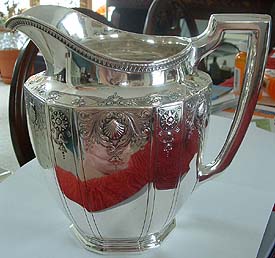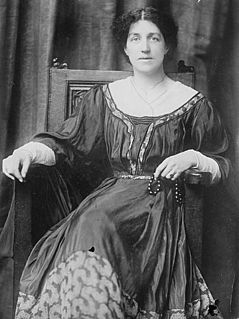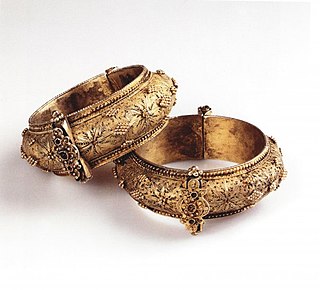Related Research Articles

A guild is an association of artisans and merchants who oversee the practice of their craft/trade in a particular area. The earliest types of guild formed as organizations of tradesmen, belonging to: a professional association, a trade union, a cartel, and/or a secret society. They sometimes depended on grants of letters patent from a monarch or other ruler to enforce the flow of trade to their self-employed members, and to retain ownership of tools and the supply of materials, but were mostly regulated by the city government. A lasting legacy of traditional guilds are the guildhalls constructed and used as guild meeting-places. Guild members found guilty of cheating on the public would be fined or banned from the guild.
Porter George Blanchard (1886–1973) was an American silversmith living and working in Pacoima, California. He is considered to be part of the Arts and Crafts Movement.

Sterling silver is an alloy of silver containing 92.5% by weight of silver and 7.5% by weight of other metals, usually copper. The sterling silver standard has a minimum millesimal fineness of 925.

A silversmith is a metalworker who crafts objects from silver. The terms silversmith and goldsmith are not exactly synonyms as the techniques, training, history, and guilds are or were largely the same but the end product may vary greatly as may the scale of objects created.

A goldsmith is a metalworker who specializes in working with gold and other precious metals. Nowadays they mainly specialize in jewelry-making but historically, goldsmiths have also made silverware, platters, goblets, decorative and serviceable utensils, and ceremonial or religious items.

A master craftsman or master tradesman was a member of a guild.

Mary "May" Morris was an English artisan, embroidery designer, jeweller, socialist, and editor. She was the younger daughter of the Pre-Raphaelite artist and designer William Morris and his wife and artists' model, Jane Morris.
The Guild of St Joseph and St Dominic was a Roman Catholic community of artists and craftspeople founded in 1920 in Ditchling, East Sussex, England. It was part of the Arts and Crafts movement and its legacy led to the creation of Ditchling Museum of Art + Craft.

Shilpa Shastras literally means the Science of Shilpa. It is an ancient umbrella term for numerous Hindu texts that describe arts, crafts, and their design rules, principles and standards. In the context of Hindu temple architecture and sculpture, Shilpa Shastras were manuals for sculpture and Hindu iconography, prescribing among other things, the proportions of a sculptured figure, composition, principles, meaning, as well as rules of architecture.
Wallace Silversmiths is a major American manufacturer of sterling silver owned by Lifetime Brands.
Argentium silver is a brand of modern tarnish-resistant silver alloys, containing either 93.5% or 96% silver. Argentium alloys replace some of the copper in the traditional sterling silver alloy with the metalloid germanium. Argentium's patents refer to percentages of zinc and boron present in Argentium silver. Both Argentium alloys exceed the standard required for hallmarking as sterling silver and Argentium silver 960 meets the standard for hallmarking as Britannia silver.

John Axel Prip, also known as Jack Prip (1922–2009), was an American master metalsmith, industrial designer, and educator. He was known for setting standards of excellence in American metalsmithing. His works and designs have become famous for bringing together the formal, technical tradition of Danish design into harmony with the American desire for innovation. Several of his designs for the Reed and Barton Company are still in production today.
Arline Fisch is an American artist and educator. She is known for her work as a metalsmith and jeweler, pioneering the use of textile processes from crochet, knitting, plaiting, and weaving in her work in metal. She developed groundbreaking techniques for incorporating metal wire and other materials into her jewelry.
Heikki Markus Seppä, also known as Heiki Seppa was a Finnish-born American master metalsmith, educator, and author. He taught at Washington University in St. Louis, from 1965 to 1992.
Phillip Sekaquaptewa was a Hopi artist and silversmith in Hopi silver overlay and stone inlay, featuring the lapidary genres of commesso and intarsia. Sekaquaptewa used colorful stones and shell for his Hopi silver overlay, not only plain silver decorated with chisel strokes on black oxide surfaces, a Hopi-signature technique known as matting.
Linda Threadgill is an American artist whose primary emphasis is metalsmithing. Her metal work is inspired by forms of nature and the interpretations she gleans from the intricate patterns it presents. She explores the foundation of nature to allude to nature and transform it into re-imagined, stylized plants forms.

Yemenite silversmithing refers to the work of Jewish silversmiths from Yemen. They were highly acclaimed craftsmen who dominated craft production in precious metals in the southern Arabian peninsula from the 18th through the mid-20th century, a period and region during which Muslims did not engage in this work. These Yemenite silversmiths were noted for their use of fine granulation and filigree, producing such ornaments as women's bracelets, necklaces, finials, etc.

Joyce Rosemary Himsworth was a British independent designer silversmith. From an early age she worked with her father, the polymath Joseph Beeston Himsworth (1874-1968) making small spoons and items of jewellery. She went on to study at Sheffield College of Arts and Craft, focusing on jewellery manufacture and enamelling. Her undoubted talents were not enough for her to gain a position within the family cutlery firm, B. Worth & Sons.
Adda "Andy" Thyra Elise Louise Husted-Andersen was a Danish-born American Modernist jeweler, silversmith, metalsmith, and educator. She was a co-founder and the president of the New York Society of Craftsmen from 1941 to 1944. She was a master of working with enamel, silver and gold. She was active in New York City and Copenhagen.
Hans Jørgen Thorvald Christensen (1924–1983) was a Danish-born American master silversmith, metalsmith, jeweler, designer, and educator. In the second half of the 20th century, he was a major contributor to handcrafted silver design in the United States.
References
- 1 2 The Artful Home: The Guild Sourcebook of Residential Art. Guild, LLC. 2005. p. 316. ISBN 978-1-880140-56-7.
- ↑ The Guild. Kraus Sikes. 1994. p. 227. ISBN 978-1-880140-10-9.
- 1 2 Suri, Charu (2019-11-19). "Endangered Crafts and the Destinations Keeping Them Alive". The New York Times. ISSN 0362-4331 . Retrieved 2021-12-15.
- 1 2 Briggeman, Kim (November 25, 2012). "Crafting Silver: Frenchtown-area man creates pieces at home" . Newspapers.com. The Montana Standard. p. D1. Retrieved 2021-12-15.
- ↑ Oakes, Elizabeth H. (2009). Ferguson Career Resource Guide to Apprenticeship Programs, Third Edition, 2-Volume Set. Infobase Publishing. p. 505. ISBN 978-1-4381-1044-8.
- ↑ "A Finding Aid to the Hans Christensen Papers, 1924-1989, bulk 1955-1983, in the Archives of American Art". SOVA.
- ↑ "Heikki Seppa". Tacoma Art Museum. Retrieved 2021-12-15.
- 1 2 Austin, Alex (2007). The Craft of Silversmithing: Techniques, Projects, Inspiration. Sterling Publishing Company, Inc. pp. 153, 155. ISBN 978-1-60059-131-0.